 The announcement of the Finnish 450 MHz cellular data licence isn’t today’s surprise; the surprise is that Flarion – the technology provider – is not announcing that Flash-OFDM is now an ITU standard. There should have been such an announcement: why the delay?
The announcement of the Finnish 450 MHz cellular data licence isn’t today’s surprise; the surprise is that Flarion – the technology provider – is not announcing that Flash-OFDM is now an ITU standard. There should have been such an announcement: why the delay?
Politics is as important as technology to the future of wireless broadband, and the battle between next generation technology providers is being fought between Qualcomm and Flarion on one hand, and Qualcomm and IP Wireless on the other.
The claim made by Flarion is that if you use normal cellphone frequencies, but add orthogonal frequency division multiplexing technology to it, you can get an order of magnitude more users per cell, and more data per user. Finland seems to have bought the idea: the first Flash-OFDM network contract has been awarded.
It could be the first domino.
Europe has been playing with Flarion technology for a couple of years. Trials have been set up – like the T-Mobile experiment in The Hague last year. And more significantly, there have been rumours of trials in Eastern Europe – countries like Lithuania and Estonia.
Traditionally, Finland has been a pioneer of high speed data, and those countries take their cue for technology from there; and the buzz in the cellular world is that several Governments in former Eastern Bloc territories will now follow suit and buy Flash-OFDM.
The Finnish contract is for re-using the old analogue phone frequencies. The same 450 MHz band is coming up for re-assignment in many European countries, and the front runners there, as in Finland, will be Qualcomm’s CDMA technology.
Qualcomm isn’t going to take that lying down. It’s been trying to lobby European and Eastern European and Middle Eastern comms authorities for a while – unsuccessfully, so far.
A couple of contracts will go to Qualcomm – because it owns majority shares in the network providers there. But this is a major setback for its plan to win back the geography it lost when GSM was invented.
 Official details of the announcement include optimistic pronouncements from Flarion, but nothing about what really matters: the need for the Flarion Flash-OFDM technology to be a standard.
Official details of the announcement include optimistic pronouncements from Flarion, but nothing about what really matters: the need for the Flarion Flash-OFDM technology to be a standard.
The reason for that, say sources in the IEEE, is simple: the standard was supposed to be announced by both the ITU and the IEEE. But the 802.20 process is stalled, and nobody who knows what is going on inside the IEEE doubts that this is because Qualcomm is lobbying fiercely, using “patriotic” arguments.
The result is that in a sense, Qualcomm will win: the ITU will adopt the Flarion technology, and the IEEE will delay its announcement – possibly for months, even years.
That will make the matter look as if it is Europe against America. That in turn could hold up the standardisation process even longer; American technology companies don’t all worship at the CDMA altar, and many of them are making fortunes out of GSM. But Congress is full of people who do not understand this. And Qualcomm lobbyists will not fail to exploit this.
The losers, of course, will be the mobile networks. They need this sort of technology if they are to survive the avalanche of ideas like BT Fusion. Fusion has gone off half-cocked, perhaps; but the idea will be refined, and not only by BT and Vodafone.
What the operators of the world need is a technology that gives them data speeds and capacities, sufficient to match what can be done with technology like WiFi and WiMAX. So Qualcomm may not, in fact, make itself too many friends by forcing people to choose between CDMA and WiFi, when their tests seem to show that there is a viable alternative.
Guy Kewney has been writing on technology for longer than most. He runs NewsWireless.net as well as writing for many including VNU.
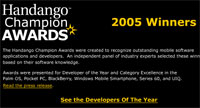 Mobile download site Handango has announced the winners of their Champion Awards at the fifth annual Handango Partner Summit.
Mobile download site Handango has announced the winners of their Champion Awards at the fifth annual Handango Partner Summit.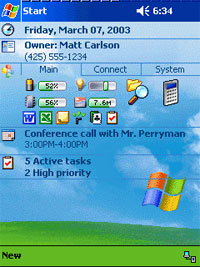 For the Palm platform, the winners included Snapper Mail Deluxe in the ‘work application’ category, with Pocket Tunes Deluxe scooping up the ‘Play’ category.
For the Palm platform, the winners included Snapper Mail Deluxe in the ‘work application’ category, with Pocket Tunes Deluxe scooping up the ‘Play’ category.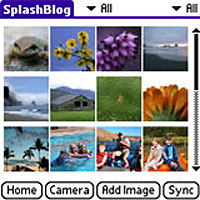 The comprehensive MobiLearn Talking Phrasebook, a talking multi-language phrasebook for the Pocket PC with “pure native voices”, snagged the “Best Industry Application” award.
The comprehensive MobiLearn Talking Phrasebook, a talking multi-language phrasebook for the Pocket PC with “pure native voices”, snagged the “Best Industry Application” award.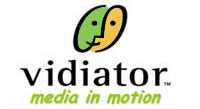 Vidiator Technology has declared a “world first” for their VeeStream mobile music video service, launched in Scandinavia.
Vidiator Technology has declared a “world first” for their VeeStream mobile music video service, launched in Scandinavia. After launching with an audio service in May 2005, video is scheduled to follow in June with radio coming in July.
After launching with an audio service in May 2005, video is scheduled to follow in June with radio coming in July.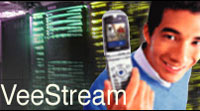 With the 3GPP/3GPP2 compliant VeeStream being player-agnostic, mobile streaming can be enabled to a broader range of networks and devices, which should bring costs down for wireless operators.
With the 3GPP/3GPP2 compliant VeeStream being player-agnostic, mobile streaming can be enabled to a broader range of networks and devices, which should bring costs down for wireless operators. The announcement of the Finnish 450 MHz cellular data licence isn’t today’s surprise; the surprise is that Flarion – the technology provider – is not announcing that Flash-OFDM is now an ITU standard. There should have been such an announcement: why the delay?
The announcement of the Finnish 450 MHz cellular data licence isn’t today’s surprise; the surprise is that Flarion – the technology provider – is not announcing that Flash-OFDM is now an ITU standard. There should have been such an announcement: why the delay?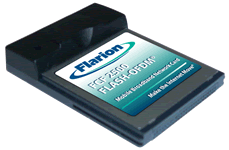 Official details of the announcement include optimistic pronouncements from Flarion, but nothing about what really matters: the need for the Flarion Flash-OFDM technology to be a standard.
Official details of the announcement include optimistic pronouncements from Flarion, but nothing about what really matters: the need for the Flarion Flash-OFDM technology to be a standard.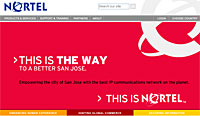 Nortel NT and BB Mobile are chuffed to bits to have achieved what they claim is the world’s “first seamless handoff of voice and data services between a third generation (3G) cellular network operating on the 1.7 GHz radio frequency band and a wireless local area network (LAN)”.
Nortel NT and BB Mobile are chuffed to bits to have achieved what they claim is the world’s “first seamless handoff of voice and data services between a third generation (3G) cellular network operating on the 1.7 GHz radio frequency band and a wireless local area network (LAN)”.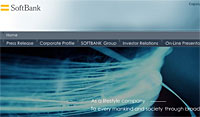 In those trials, boffins were able to notch up Japan’s first 14.4 million bits per second (Mbps) wireless data transmission via the 1.7 GHz radio frequency band for mobile communications and Nortel’s high-speed downlink packet access (HSDPA) technology.
In those trials, boffins were able to notch up Japan’s first 14.4 million bits per second (Mbps) wireless data transmission via the 1.7 GHz radio frequency band for mobile communications and Nortel’s high-speed downlink packet access (HSDPA) technology. A note at the end of the press announcement: “Certain information included in this press release is forward-looking and is subject to important risks and uncertainties. The results or events predicted in these statements may differ materially from actual results or events….”
A note at the end of the press announcement: “Certain information included in this press release is forward-looking and is subject to important risks and uncertainties. The results or events predicted in these statements may differ materially from actual results or events….”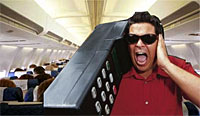 A survey by technology researchers IDC revealed that passengers aren’t too keen on the prospect of spending long flights listening to fellow passengers bellowing into their mobile phones.
A survey by technology researchers IDC revealed that passengers aren’t too keen on the prospect of spending long flights listening to fellow passengers bellowing into their mobile phones. The growth of clever-clogs smartphones phones like the i-mate JAM and PalmOne Treo would allow connected passengers to check their email and surf the web during flights.
The growth of clever-clogs smartphones phones like the i-mate JAM and PalmOne Treo would allow connected passengers to check their email and surf the web during flights.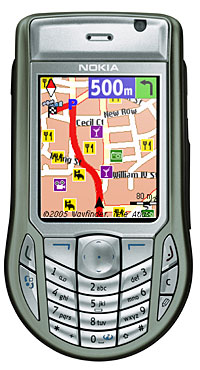 Nokia and Wayfinder Systems have proudly proclaimed the availability of the Nokia 6630 Navigation Pack, a compact smartphone-based navigation package for folks on the move.
Nokia and Wayfinder Systems have proudly proclaimed the availability of the Nokia 6630 Navigation Pack, a compact smartphone-based navigation package for folks on the move.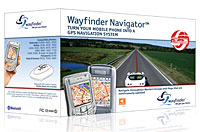 Never one to knowingly undersell his product, Jonas Sellergren, VP Product Management, Wayfinder Systems proclaimed “the Wayfinder Navigator application on the Nokia 6630 brings the ultimate navigation solution to the consumer.”
Never one to knowingly undersell his product, Jonas Sellergren, VP Product Management, Wayfinder Systems proclaimed “the Wayfinder Navigator application on the Nokia 6630 brings the ultimate navigation solution to the consumer.” Emerging blinking from their underground laboratories, the overworked boffins at Samsung have announced the creation of the SGH-E620 Bluetooth voice recognition phone which is a Bluetooth mobile with – you guessed it! – voice recognition technology.
Emerging blinking from their underground laboratories, the overworked boffins at Samsung have announced the creation of the SGH-E620 Bluetooth voice recognition phone which is a Bluetooth mobile with – you guessed it! – voice recognition technology. Vodafone has made their service more alluring to international business travellers by cutting roaming charges on their 3G data networks.
Vodafone has made their service more alluring to international business travellers by cutting roaming charges on their 3G data networks.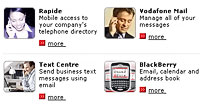 According to analysts Gartner, the new prices demonstrate that operators are currently charging too much; “This is a sign that mobile operators are starting to recognise they charge too much for roaming data services,” they added, as your writer’s head nodded vigorously in agreement (while making snarling noises in the direction of T-Mobile).
According to analysts Gartner, the new prices demonstrate that operators are currently charging too much; “This is a sign that mobile operators are starting to recognise they charge too much for roaming data services,” they added, as your writer’s head nodded vigorously in agreement (while making snarling noises in the direction of T-Mobile). Gartner noted that with Vodafone only selling sold 300,000 3G data cards since launching the 3G data network in January 2004, the company is hoping that the reduced roaming charges will boost this figure.
Gartner noted that with Vodafone only selling sold 300,000 3G data cards since launching the 3G data network in January 2004, the company is hoping that the reduced roaming charges will boost this figure. After a long cuddle on the sofa, Napster and Ericsson have announced a global partnership to offer a fully integrated new digital music service aimed at mobile phone customers around the world.
After a long cuddle on the sofa, Napster and Ericsson have announced a global partnership to offer a fully integrated new digital music service aimed at mobile phone customers around the world. The two companies hope that their service will allow mobile operators to get their grubby mitts on the “growth opportunities for personalised digital entertainment on the mobile phone and PC” and will, no doubt, include the usual slew of lucrative, downloadable offerings like ringtones, master tones, images, wallpaper and video content.
The two companies hope that their service will allow mobile operators to get their grubby mitts on the “growth opportunities for personalised digital entertainment on the mobile phone and PC” and will, no doubt, include the usual slew of lucrative, downloadable offerings like ringtones, master tones, images, wallpaper and video content. More and more mobile operators are already cutting themselves a slice of the mobile digital music services pie, with the largest Korean mobile phone operator recently purchasing a controlling stake in the country’s biggest record label.
More and more mobile operators are already cutting themselves a slice of the mobile digital music services pie, with the largest Korean mobile phone operator recently purchasing a controlling stake in the country’s biggest record label. T-Mobile USA today revealed that nearly half a million are currently signed up to access their hotspots with hourly, daily, monthly or yearly accounts
T-Mobile USA today revealed that nearly half a million are currently signed up to access their hotspots with hourly, daily, monthly or yearly accounts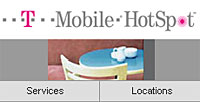 Although many early Wi-Fi adopters were laptop-toting business suits connecting in airports, hotel rooms and lobbies, the demographic is now far broader, with students, music fans, backpackers, silver surfers and others hitting the hotspots with their PDAs, smartphones and laptops.
Although many early Wi-Fi adopters were laptop-toting business suits connecting in airports, hotel rooms and lobbies, the demographic is now far broader, with students, music fans, backpackers, silver surfers and others hitting the hotspots with their PDAs, smartphones and laptops.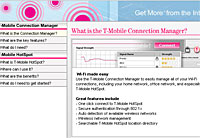 New locations include the provision of roaming access throughout another 39 more airports in North America (making a total of 75 airports covered), with Wi-Fi guest room access being installed at 525 more hotels in the Marriott, Hilton, Ritz-Carlton, Doubletree and Renaissance chains.
New locations include the provision of roaming access throughout another 39 more airports in North America (making a total of 75 airports covered), with Wi-Fi guest room access being installed at 525 more hotels in the Marriott, Hilton, Ritz-Carlton, Doubletree and Renaissance chains.